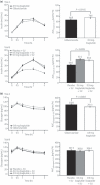The once-daily human glucagon-like peptide-1 analog, liraglutide, improves β-cell function in Japanese patients with type 2 diabetes
- PMID: 24843595
- PMCID: PMC4019260
- DOI: 10.1111/j.2040-1124.2012.00193.x
The once-daily human glucagon-like peptide-1 analog, liraglutide, improves β-cell function in Japanese patients with type 2 diabetes
Abstract
Aims/Introduction: β-cell function was evaluated by homeostasis model assessment of β-cell function (HOMA-B) index, proinsulin:insulin and proinsulin:C-peptide ratios in adult, Japanese type 2 diabetes patients receiving liraglutide.
Materials and methods: Data from two randomized, controlled clinical trials (A and B) including 664 Japanese type 2 diabetes patients (mean values: glycated hemoglobin [HbA1c] 8.61-9.32%; body mass index [BMI] 24.4-25.3 kg/m(2)) were analyzed. In two 24-week trials, patients received liraglutide 0.9 mg (n = 268) or glibenclamide 2.5 mg (n = 132; trial A), or liraglutide 0.6, 0.9 mg (n = 176) or placebo (n = 88) added to previous sulfonylurea therapy (trial B).
Results: Liraglutide was associated with improved glycemic control vs sulfonylurea monotherapy or placebo. In liraglutide-treated groups in trials A and B, area under the curve (AUC) insulin 0-3 h was improved (P < 0.001 for all) and the AUCinsulin 0-3 h:AUCglucose 0-3 h ratio was increased (estimated treatment difference [liraglutide-comparator] 0.058 [0.036, 0.079]). HOMA-B significantly increased with liraglutide relative to comparator in trial B (P < 0.05), but not in trial A. The reduction in fasting proinsulin:insulin ratio was 50% greater than in comparator groups.
Conclusions: In Japanese type 2 diabetes patients, liraglutide was associated with effective glycemic control, restoration of prandial insulin response and indications of improved β-cell function. This trial was registered with Clinicaltrials.gov (trial A: no. NCT00393718/JapicCTI-060328 and trial B: no. NCT00395746/JapicCTI-060324). (J Diabetes Invest, doi: 10.1111/j.2040-1124.2012.00193.x, 2012).
Keywords: Insulin‐secreting cells; Liraglutide; Type 2 diabetes.
Figures

Similar articles
-
Glucagon-like peptide-1 analog liraglutide in combination with sulfonylurea safely improves blood glucose measures vs sulfonylurea monotherapy in Japanese patients with type 2 diabetes: Results of a 52-week, randomized, multicenter trial.J Diabetes Investig. 2011 Aug 2;2(4):280-6. doi: 10.1111/j.2040-1124.2011.00103.x. J Diabetes Investig. 2011. PMID: 24843499 Free PMC article.
-
Fifty-two-week, randomized, multicenter trial to compare the safety and efficacy of the novel glucagon-like peptide-1 analog liraglutide vs glibenclamide in patients with type 2 diabetes.J Diabetes Investig. 2011 Nov 30;2(6):441-7. doi: 10.1111/j.2040-1124.2011.00128.x. J Diabetes Investig. 2011. PMID: 24843528 Free PMC article.
-
One week's treatment with the long-acting glucagon-like peptide 1 derivative liraglutide (NN2211) markedly improves 24-h glycemia and alpha- and beta-cell function and reduces endogenous glucose release in patients with type 2 diabetes.Diabetes. 2004 May;53(5):1187-94. doi: 10.2337/diabetes.53.5.1187. Diabetes. 2004. PMID: 15111485 Clinical Trial.
-
The once-daily human glucagon-like peptide-1 (GLP-1) analog liraglutide improves postprandial glucose levels in type 2 diabetes patients.Adv Ther. 2011 Mar;28(3):213-26. doi: 10.1007/s12325-010-0110-x. Epub 2011 Feb 17. Adv Ther. 2011. PMID: 21340616 Clinical Trial.
-
A review of efficacy and safety data regarding the use of liraglutide, a once-daily human glucagon-like peptide 1 analogue, in the treatment of type 2 diabetes mellitus.Clin Ther. 2009 Nov;31(11):2472-88. doi: 10.1016/j.clinthera.2009.11.034. Clin Ther. 2009. PMID: 20109994 Review.
Cited by
-
Once-weekly glucagon-like peptide-1 receptor agonist dulaglutide is non-inferior to once-daily liraglutide and superior to placebo in Japanese patients with type 2 diabetes: a 26-week randomized phase III study.Diabetes Obes Metab. 2015 Oct;17(10):974-83. doi: 10.1111/dom.12534. Epub 2015 Aug 20. Diabetes Obes Metab. 2015. PMID: 26179187 Free PMC article. Clinical Trial.
-
Retrospective analysis of safety and efficacy of insulin-to-liraglutide switch in Japanese type 2 diabetes: A caution against inappropriate use in patients with reduced β-cell function.J Diabetes Investig. 2013 Nov 27;4(6):585-94. doi: 10.1111/jdi.12111. Epub 2013 Jun 25. J Diabetes Investig. 2013. PMID: 24843713 Free PMC article.
-
iGlarLixi provides improved early glycaemic control after 12 weeks of treatment compared with basal insulin in Asian people with type 2 diabetes: A post hoc analysis of the LixiLan-O-AP and LixiLan-L-CN studies.Diabetes Obes Metab. 2025 May;27(5):2593-2600. doi: 10.1111/dom.16260. Epub 2025 Feb 27. Diabetes Obes Metab. 2025. PMID: 40013432 Free PMC article. Clinical Trial.
-
Effect of liraglutide on blood pressure: a meta-analysis of liraglutide randomized controlled trials.BMC Endocr Disord. 2019 Jan 7;19(1):4. doi: 10.1186/s12902-018-0332-5. BMC Endocr Disord. 2019. PMID: 30616638 Free PMC article.
-
How Effective Is the Fixed-Ratio Combination of Insulin Degludec and Liraglutide (IDegLira) in Different Patient Populations, and When Should It Be Used in Clinical Practice?Clin Diabetes. 2020 Oct;38(4):339-347. doi: 10.2337/cd20-0014. Clin Diabetes. 2020. PMID: 33132503 Free PMC article.
References
-
- Morimoto A, Nishimura R, Tajima N. Trends in the epidemiology of patients with diabetes in Japan. Jpn Med Assoc J 2010; 53: 36–40
-
- Kawamori R. Diabetes trends in Japan. Diabetes Metab Res Rev 2002; 18(Suppl. 3): S9–S13 - PubMed
-
- Fukushima M, Usami M, Ikeda M, et al. Insulin secretion and insulin sensitivity at different stages of glucose tolerance: a cross‐sectional study of Japanese type 2 diabetes. Metab Clin Exp 2004; 53: 831–835 - PubMed
-
- Kobayashi M, Yamazaki K, Hirao K, et al. The status of diabetes control and antidiabetic drug therapy in Japan – a cross‐sectional survey of 17,000 patients with diabetes mellitus (JDDM 1). Diabetes Res Clin Pract 2006; 73: 198–204 - PubMed
-
- Kahn SE, Haffner SM, Heise MA, et al. Glycemic durability of rosiglitazone, metformin or glyburide monotherapy. N Engl J Med 2006; 355: 2427–2443 - PubMed
Associated data
LinkOut - more resources
Full Text Sources
Medical

